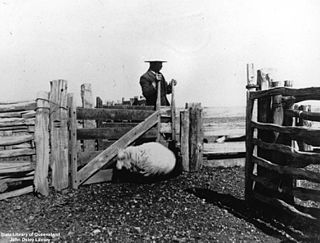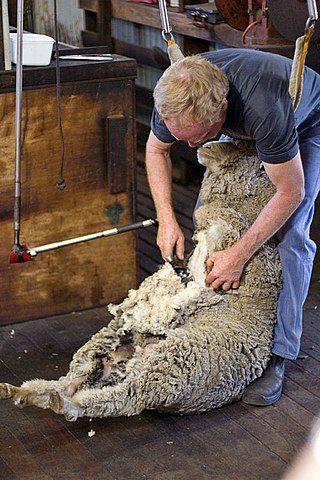
Sheep shearing is the process by which the woollen fleece of a sheep is cut off. The person who removes the sheep's wool is called a shearer. Typically each adult sheep is shorn once each year. The annual shearing most often occurs in a shearing shed, a facility especially designed to process often hundreds and sometimes more than 3,000 sheep per day.

Ilfracombe is a rural town and locality in the Longreach Region, Queensland, Australia. In the 2016 census, the locality of Ilfracombe had a population of 259 people.

The Golden Fleece, originally known as Shearing at Newstead, is an 1894 painting by the Australian artist Tom Roberts. The painting depicts sheep shearers plying their trade in a timber shearing shed at Newstead North, a sheep station near Inverell on the Northern Tablelands of New South Wales. The same shed is depicted in another of Roberts' works, Shearing Shed, Newstead (1894).

Cordillo Downs or Cordillo Downs Station is both a pastoral lease currently operating as a cattle station and a formal bounded locality in South Australia. It is located about 116 kilometres (72 mi) north of Innamincka and 155 kilometres (96 mi) south east of Birdsville. The name and boundaries of the locality were created on 26 April 2013 for the long established local name.

Wellshot Station is a pastoral lease that operates as a sheep station. It is located about 45 kilometres (28 mi) south of Ilfracombe and 175 kilometres (109 mi) north of Jundah in Queensland, Australia.
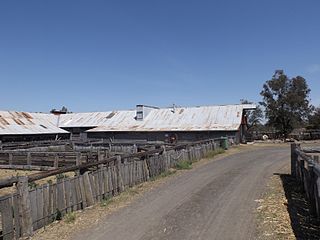
Jondaryan Woolshed is a heritage-listed shearing shed at Evanslea Road, Jondaryan, Queensland, Australia. It was built in 1859-60 to replace an earlier, smaller woolshed on the former Jondaryan pastoral station, which was at one stage the largest freehold station in Queensland. The woolshed was the scene of significant labour conflict in the late 1880s and early 1890s, as the station became a test case for the new Queensland Shearers Union in the lead-up to the 1891 Australian shearers' strike.

Nindooinbah Homestead is a heritage-listed homestead at Nindooinbah Connection Road, Nindooinbah, Scenic Rim Region, Queensland, Australia. It was built from c. 1858 to 1907. It is also known as Nindooinbah House. It was added to the Queensland Heritage Register on 21 October 1992.
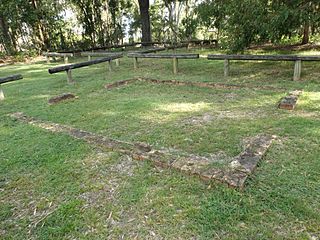
Ormiston Fellmongery is a heritage-listed archaeological site of a former wool scour and fellmongery at Sturgeon Street, Ormiston, City of Redland, Queensland, Australia. It is also known as Fellmonger Park. It was added to the Queensland Heritage Register on 18 September 2009.

The Glebe Homestead is a heritage-listed homestead at Taroom-Cracow Road, Glebe near Taroom, Shire of Banana, Queensland, Australia. It was designed by Florence Mary Rigby and built c. 1920. It is also known as Broadwater. It was added to the Queensland Heritage Register on 23 March 2007.

Langenbaker House is a heritage-listed detached house at Mitchell Street, Ilfracombe, Longreach Region, Queensland, Australia. It was erected in Ilfracombe in 1899, but was originally built earlier at another location. It was added to the Queensland Heritage Register on 29 November 2001.

Blackall Woolscour is a heritage-listed wool scour at Evora Road, 4 kilometres (2.5 mi) northeast of Blackall, Queensland, Australia. It was built from 1908 to 1920s circa. It was added to the Queensland Heritage Register on 21 October 1992.

Isis Downs Woolshed is a heritage-listed shearing shed at Isisford-Blackall Road, Isisford, Longreach Region, Queensland, Australia. It was designed by Kay, MacNicol and Company Engineers and built from 1913 to 1914 by Dorman Long and Company (Melbourne). It was added to the Queensland Heritage Register on 18 September 2008.
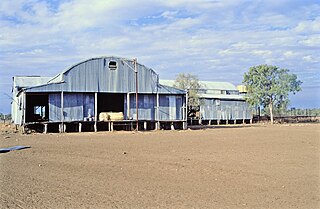
Darr River Downs is a heritage-listed homestead at Landsborough Highway, Morella, Longreach Region, Queensland, Australia. It was built from 1870s circa to 1900s circa. It was added to the Queensland Heritage Register on 27 June 2003.
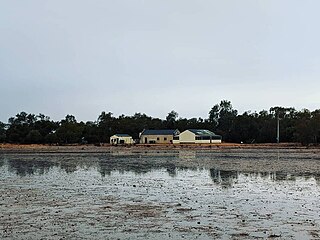
The Mount Wood Station, also known as simply Mt Wood, is a heritage-listed former cattle station that now forms part of the Sturt National Park in Tibooburra in the Unincorporated Far West region of New South Wales, Australia. The cattle station was built between 1890 and 1969. As a national park, the property is owned by the NSW Officer of Environment and Heritage, an agency of the Government of New South Wales. It was added to the New South Wales State Heritage Register on 2 April 1999.
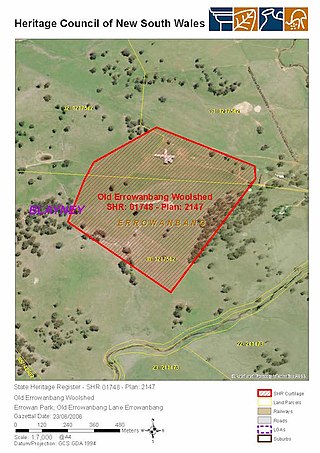
Old Errowanbang Woolshed is a heritage-listed shearing shed at Errowan Park, Old Errowanbang Lane, Errowanbang, Blayney Shire, New South Wales, Australia. It was designed by Watt and built in 1886. It is also known as Errowanbang Woolshed. It was added to the New South Wales State Heritage Register on 23 June 2006.

Kinchega Woolshed is a heritage-listed former shearing shed located 15km south-west of Menindee township, Central Darling Shire, New South Wales, Australia. It was built from in 1875. The property is owned by the New South Wales Office of Environment and Heritage. It was added to the New South Wales State Heritage Register on 2 April 1999.
Mulwala Homestead is a heritage-listed homestead at North Road, Mulwala, New South Wales, Australia. It was added to the Australian Commonwealth Heritage List on 22 June 2004.
Windy Station Woolshed is a heritage-listed shearing shed at Windy Road, Pine Ridge, Liverpool Plains Shire, New South Wales, Australia. It was designed by Fred B Menkens and built in 1901 by Thomas and William Cowan. It was added to the New South Wales State Heritage Register on 19 January 2018.
East Warrah Woolshed is a heritage-listed shearing shed at Merriwa-Murrurundi Road, Warrah Creek, Liverpool Plains Shire, New South Wales, Australia. It was designed by Samuel Craik and built from 1863 to 1864. It was added to the New South Wales State Heritage Register on 10 August 2018.








